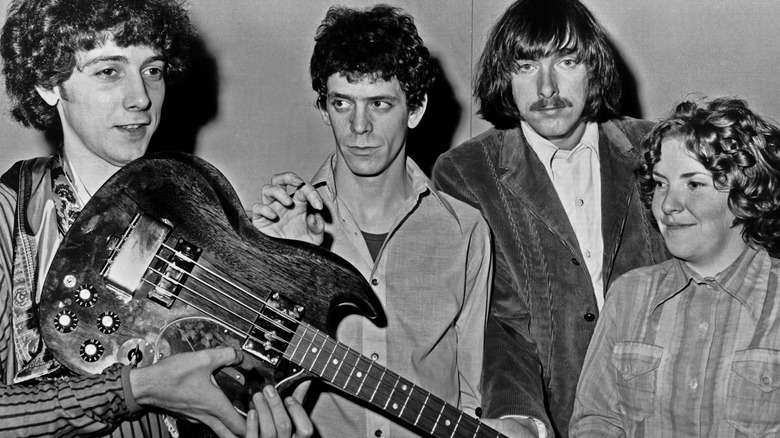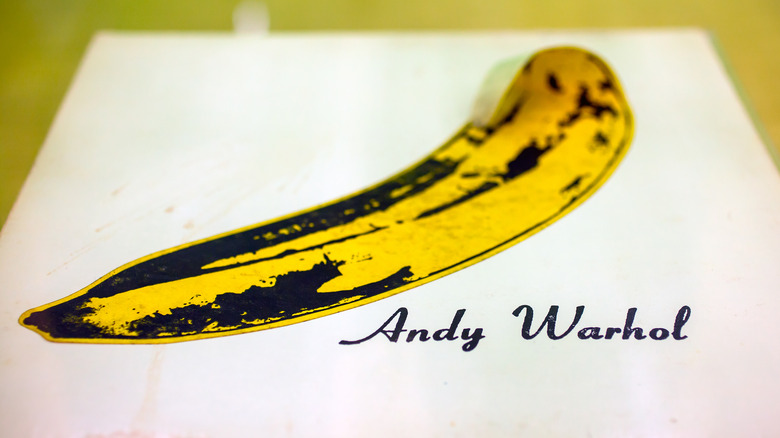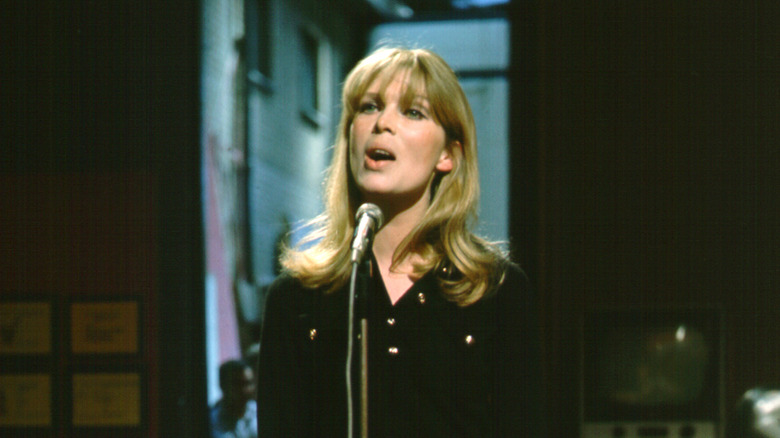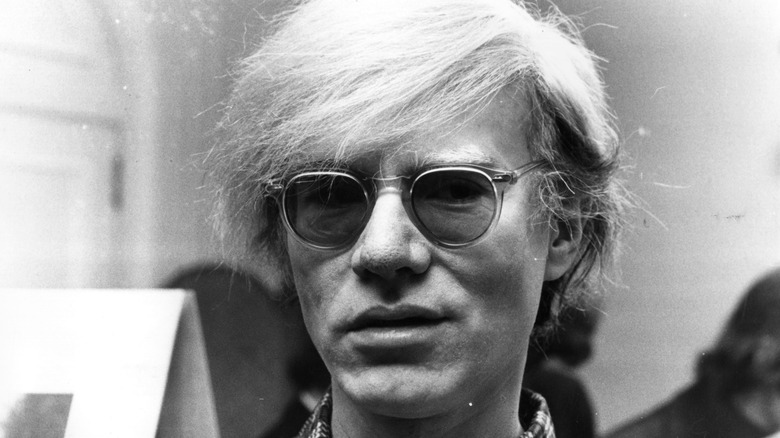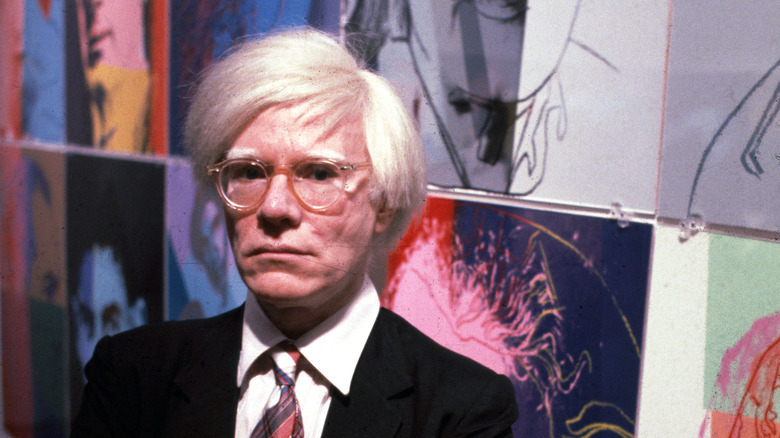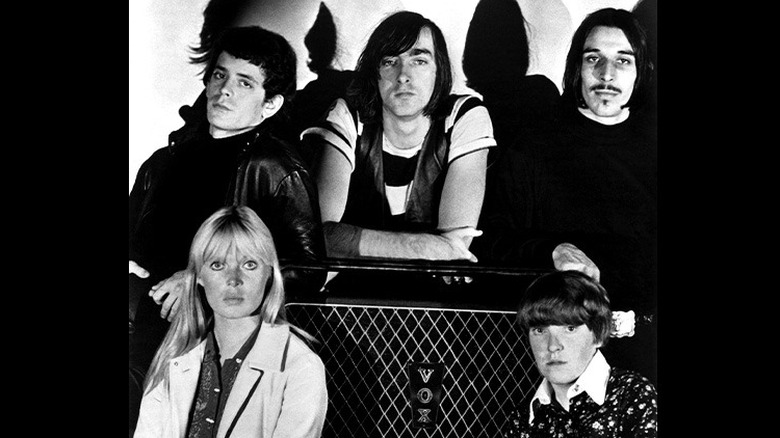The Velvet Underground's Relationship With Andy Warhol Explained
While The Velvet Underground is known as one of the most influential bands of all time, less known is that iconic artist Andy Warhol was one of the main factors behind their success. According to Classic Album Sundays, the band was first formed in 1965 by Lou Reed and John Cale, with Sterling Morrison and Moe Tucker, the younger sister of a friend, later joining to complete the group. While most of the music of the time was Woodstock-inspired, The Velvet Underground had an almost grunge or punk feel in their mission to be as anti-establishment as possible.
The band was performing at Café Bizarre in New York's Greenwich Village when Andy Warhol was in the audience. Warhol was at the peak of his popularity at the time, having released his famous Campbell's Soup and Marilyn Monroe prints a few years beforehand. His latest mission was a multimedia project, and since The Velvet Underground fit the bill perfectly, he offered to be their manager. The band unsurprisingly accepted.
As detailed in Another Magazine, Warhol's new role catapulted the relatively unknown group to fame almost instantly, and they became the official house band at the Silver Factory, Warhol's famed art studio. In addition, the band played at Warhol's film screenings and even traveled on his mixed-media Exploding Plastic Inevitable tour. Later, Warhol also became one of their producers after helping finance the band's first album.
Andy Warhol was also behind this iconic cover
For Warhol, branching out into managing and producing a band was part of his mission to try to "do it all," even if that meant stepping back from art, per Far Out Magazine.
Meanwhile, The Velvet Underground members noted that just being around Warhol and his cohorts influenced their music and artistic ideas.
"All I did was sit [at Andy Warhol's factory] and observe these incredibly talented and creative people who were continually making art, and it was impossible not to be affected by that," Reed later said of the experience.
However, Warhol's album artwork for "The Velvet Underground and Nico" is generally considered his most famous influence on the band. Warhol designed the cover to be an illustration of a banana on a blank background.
Near the top corner of the banana was the phrase "peel slowly and see" written in small letters. Purchasers could then actually peel the top corner of the yellow fruit, like a sticker, to reveal an image of a pink banana underneath. Beneath the banana was Warhol's signature.
The design was one of the first examples of a mixed media cover for an album, and its novelty status was only heightened by the risqué nature of un-peeling a banana, per U Discover Music.
Andy Warhol also demanded a certain singer join the band
Warhol was a strong proponent of artistic freedom, and in following with his ethos, allowed The Velvet Underground to work mostly on their own without interference while in the recording studio.
"He just made it possible for us to be ourselves and go right ahead with it," Reed said of Warhol's managerial skills, via Classic Album Sundays.
However, there were two aspects in which Warhol did flex his authority as the band's manager. The first was enlisting German singer Nico to feature on the group's first album.
Nico, also known as Nicolina, had been a breakout star thanks to her role in Italian film director Federico Fellini's "La Dolce Vita," and Warhol believed that her unique voice combined with her it-girl status would be the perfect combination for the band's debut album.
He wasn't wrong, and Warhol eventually managed to win the band a recording contract with MGM's Verve Records, according to Another Magazine. The album would end up becoming "The Velvet Underground and Nico."
However, the addition of Nico was not without its drawbacks. Allegedly, Warhol didn't even consult the group before making the addition, which unsurprisingly rubbed some of the band members — especially Reed — the wrong way.
"When he put Nico in the band, we said, 'Hmmm,'" Reed explained, per Far Out Magazine. "Andy said, 'Oh, you've got to have a chanteuse.' I said, 'Oh, Andy, give us a break.'"
Andy Warhol was also majorly focused on the band's PR image
The second way in which Warhol flexed his managerial chops was an intense focus on the band's image. Publicly, the band was undoubtedly known to be linked to Warhol and inherited some of his caché. But Warhol sought to brand the band in artistic and unique ways even behind the scenes.
Though most bands have at least some recordings of their performances, The Velvet Underground is unusual in that most of their footage is actually of their rehearsals. Even more unusual is that the videos were filmed by none other than Andy Warhol himself.
In fact, filmmaker Todd Haynes noted in an interview with The Sydney Morning Herald that the behind-the-scenes clips were arguably better than any recording of a show because they transported the viewer in a way that an act could not.
"They were depicted, shown rehearsing, playing with their instruments, not necessarily on stage but there are glimpses of stage stuff, as if you were really there on a lot of drugs and seeing them through the shimmer of lights. In terms of putting the viewer in the time and place, you couldn't improve on that," he claimed.
Some of the clips unmistakably leaned into Warhol's artistic side. For example, Warhol often asked his subjects to stare into the camera without blinking for as long as possible, shattering the fourth wall.
It was this conflict that earned Andy Warhol his band nickname -- and what got him fired
Ironically, the closeness to Warhol ended up becoming a major source of friction. The band recognized that they owed Warhol a debt of gratitude but his control and notoriety could also be overwhelming.
"'Produced by Andy Warhol' ... it was like being a soup can," Reed once complained, per High Brow Magazine.
The hot-and-cold relationship even earned Warhol the nickname "Drella" from the band. As described in Another Magazine, the name was a combination of Dracula and Cinderella.
Though the moniker was actually first coined by the famed actor Ondine, the name was quickly adopted by the group as a recognition that their manager was both responsible for their rags-to-riches story and was a controlling shadow over the group.
Eventually, Warhol's meddling became too much for Reed to handle. In a meeting between the two, Warhol asked the guitarist about his vision of the band's future. When Reed realized it was not in line with Warhol's, he fired him on the spot.
Warhol did not take the termination well.
"I'd never seen Andy angry, but I did that day. He was really mad. Called me a rat. That was the worst thing he could think of," Reed later said of the uncomfortable discussion, per Far Out Magazine.
Andy Warhol's departure from The Velvet Underground was a death knell for the band
Reed fired Warhol without receiving approval or even giving forewarning to his bandmates, and they were understandably upset about his rash decision.
"The way [Reed] handled it and the way he did it was really destructive. I mean he just like blew up the band and fired Andy without telling anybody, and it was like, 'What?'" Cale said of the fall-out.
Shortly after Warhol's departure, Nico decided to part ways with The Velvet Underground as well. Though the band managed to work together for one more album, it was an uneasy working environment filled with unease, conflict, and resentment.
Reed dealt with the situation in a similarly brusque way as he dealt with Warhol: he demanded another firing. This time, he went after Cale. According to Another Magazine, he called a meeting and requested that either Cale leave or the band break up. Cale was replaced, but the band never really recovered. It relied on a different folk-like sound and disbanded a few years later in 1973.
Despite The Velvet Underground's short lifespan, music historians and aficionados have nevertheless called the group one of the most influential of all time, per Classic Album Sundays.
"What we had was ambition and a goal ... to elevate the rock 'n' roll song and take it where it hadn't been taken before," Reed said of the band's mission, and they certainly succeeded.
